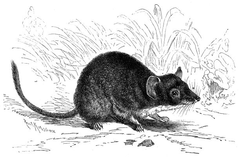Antechinus
| Antechinus | |
|---|---|
 |
|
| Antechinus flavipes, from Brehms Tierleben | |
| Scientific classification | |
| Kingdom: | Animalia |
| Phylum: | Chordata |
| Class: | Mammalia |
| Order: | Dasyuromorphia |
| Family: | Dasyuridae |
| Subfamily: | Dasyurinae |
| Tribe: | Phascogalini |
| Genus: |
Antechinus Macleay, 1841 |
| Type species | |
|
Antechinus stuartii Macleay, 1841 |
|
| Species | |
Antechinus /æntɪˈkaɪnəs/ ('ant-echinus') is a genus of small dasyurid marsupial indigenous to Australia, Tasmania and New Guinea. They resemble mice with the bristly fur of shrews. The majority of Antechinus species occur in Australia and only two species have been described in New Guinea. They are sometimes also called broad-footed marsupial mice, pouched mice, route rat and/or antechinus shrews. However, these common names are considered either regional or archaic and the modern common name for the animals is "antechinus".
Antechinuses are small, carnivorous, shrew-like animals that primarily prey on invertebrates such as spiders, beetles (including larvae), and weevils. Some are strictly terrestrial and hunt only at ground level, while others are arboreal (tree-climbing) in nature. Most species nest communally in tree-hollows. Their primary habitats are: swamps, tropical rainforests, temperate rainforests and woodlands.
Antechinuses have short hair and vary from grey-cinnamon-brown-black in colour depending on the species. They have prominent whiskers, large ears and a pronounced, pointed snout, giving them an overall shrew-like appearance. Species vary from 80–120 mm, nose-to-tail (80 mm = female A. agilis, 120 mm = male A. swainsonii) and weight 16–170 g (16 g = female A. agilis, 170 g = male A. swainsonii) when fully grown.
Sexual dimorphism occurs in most species for both weight and skeletal measurements, with males being typically larger and heavier. A. agilis is the smallest known species, and A. swainsonii the largest. Species in Papua New Guinea are not well documented and unknown Papuan species and subspecies likely await discovery.
All Antechinus species except for A. swainsonii are semelparous at least as males – and usually as females, too – meaning that an individual usually only lives long enough to breed once in its lifetime. Breeding occurs in winter (usually August–September) at a time when little food is available in the environment.
To accomplish this, a male strips its body of vital proteins and also suppresses the immune system so as to free up additional metabolic energy. In this way, an individual male trades away long-term survival in return for short-term breeding success, and following the breeding season, a complete die-off of physiologically exhausted males occurs. Breeding is intensely competitive. Males produce large amounts of testosterone and mate-guarding occurs in the form of protracted copulation (up to twelve hours in some species).
...
Wikipedia
